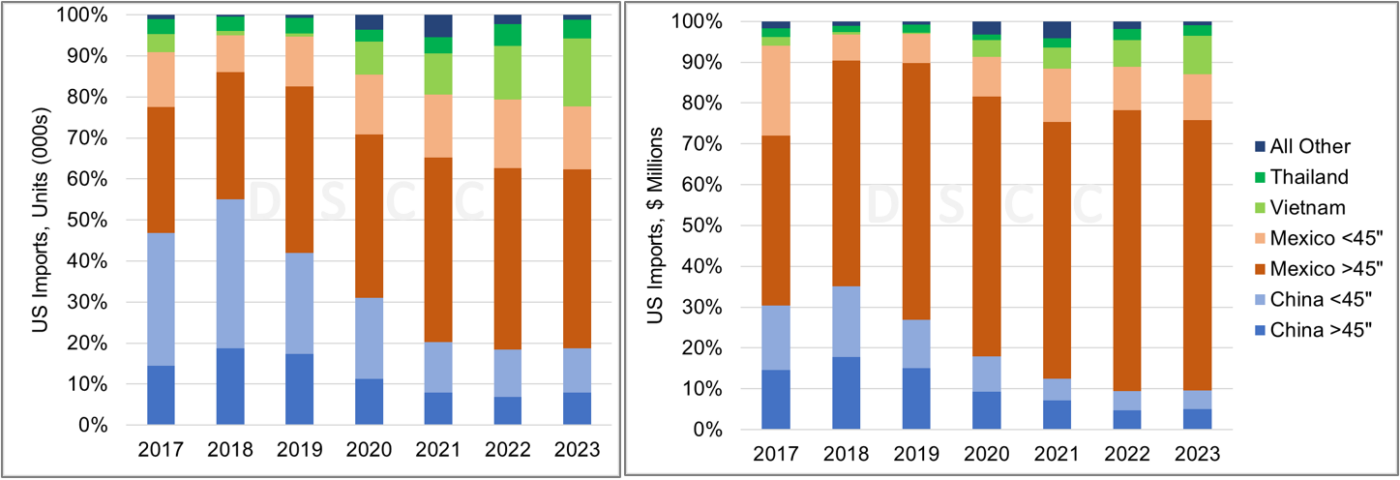米国が中国からの輸入TVに対する関税を引き上げ?可能性は低そう
冒頭部和訳
中国からの輸入TVに対する米国の関税引き上げの懸念について、DSCCはこれまでに複数の業界関係者から話を聞いている。関係者はいずれも引き上げの「噂」について話しており、Digitimesの記事もこの噂について言及している。この噂には根拠がなく、米国の政治制度と判断がどのように行われるかについての大きな誤解から生じたものである、というのがDSCCの見解だ。
DSCCが先週報告したように、そして以下のグラフが示すように、中国から米国に輸入されるTVは2018年をピークに近年大幅に減少している。この年、米国は2500万台近くのTVを平均価格 186ドルで中国から輸入、総収益は46億ドルだった。2018年の輸入が大きく伸びた要因として、中国製品に関税を課すというトランプ政権の脅しによる年後半の急増が挙げられる。
関税は実際には2019年9月に15%の追加関税として実施され、その後、トランプ大統領と中国の習国家主席との「第1段階」貿易協定の一環として、7.5%に引き下げられた。この関税は現在も適用されており、アジアから米国に輸入されるその他のTVに対する従来の3.9%関税に追加されている。メキシコから米国に輸入されるTVについては、USMCA (旧NAFTA) 自由貿易地域に基づいて関税が免除されている。
グラフが示すように、米国の輸入TVのうちメキシコからのものは台数ベースでほぼ60%、金額ベースでは70%以上となっており、中国からの輸入TVの割合は台数ベースで53%から19%へ、金額ベースでは35%から10%へと低下している。メキシコからの輸入のほか、タイから、そして特にベトナムからの輸入も増加している。
Will the US Increase Tariffs on China TVs? Not Likely
※ご参考※ 無料翻訳ツール (DeepL)
DSCC has heard from several of our contacts in the industry regarding some concerns about the USA increasing its tariff on TVs imported from China. Each of these contacts mention “rumors” of such an increase, and an article in Digitimes also made reference to such rumors. Our opinion is that these rumors have no basis and are generated from a profound misunderstanding of the US political system and the way such decisions are made.
As we reported last week and as shown on the charts here, US TV imports from China have declined substantially in recent years after peaking in 2018. In that year, the US had nearly 25M TVs imported from China at an average price of $186 for a total revenue of $4.6B. The 2018 imports were fueled by a surge late in the year as the Trump Administration threatened to impose tariffs on Chinese goods.
Those tariffs were actually implemented in September 2019 with an extra 15% duty, which was subsequently reduced to 7.5% as part of Trump’s “Phase 1” trade deal with President Xi of China. That duty remains in place today and adds to the existing 3.9% duty on other TVs imported into the US from Asia. TVs imported to the US from Mexico come in duty-free based on the USMCA (formerly NAFTA) free trade zone.
As shown on the charts, nearly 60% of US TV units and more than 70% of US TVs by value are imported from Mexico, and the portion of TVs imported from China has fallen from 53% to 19% of units and fallen from 35% to 10% of value. Imports from Thailand and especially Vietnam have increased, along with those from Mexico.
US TV Import Share by Country, 2017-2023. Units (L) and Revenue (R)
Before the US implemented the tariffs in 2019, there was an extensive period of public comment generated by the office of the US Trade Representative (USTR). The original proposal from the USTR in 2018 asked for a 25% duty on all imports from China. In a public comments period in 2018, many companies, including Best Buy, Apple and Dell, argued against the tariffs. Further the Consumer Technology Association (CTA), the main consumer electronics industry association in the US, which organizes the CES show, also spoke against the tariffs.
If the US were to implement another round of tariffs on imports from China, there would be a similar call for public comments, and we can expect that Best Buy and other companies would speak out against such a step. Perhaps more importantly, there are no voices within the US calling for such an increase. Whereas there are some industries with a substantial US presence that argue for trade action – semiconductors, autos and solar panels all come to mind – there is no such presence in the US for TV makers.
One variant of the rumors circulating in China has been that the US would impose tariffs on TVs from any country if the flat panel display panels came from China. Such a change would be difficult to implement because it would force importers to document the subcomponents of the end product. More importantly, it could not be implemented by the US unilaterally within the US-Canada-Mexico free trade zone. The USMCA treaty governs US imports from Mexico, and it includes no language specifying the flat panel origin of TV imports. In order to insert such language, there would need to be a change in the USMCA, and there is no prospect of any renegotiation of that treaty before the presidential election in 2024.
While the Biden Administration has largely followed the Trump Administration’s trade war on China, when it has taken additional actions those have been much more focused. Biden has increased the number of products under a US export ban to protect the semiconductor industry and has expanded the number of Chinese companies under US trade sanctions. Although they have left in place the punitive tariffs introduced by Trump, the Biden Administration has not yet raised the prospects of higher tariffs.
One reason that Biden is extremely unlikely to more to increase tariffs concerns one of the main arguments against tariffs – that tariffs increase prices for consumers. During the Trump years, inflation was a distant memory and not a political weapon, but the pandemic surge in demand for products led inflation to its highest point in 40 years, and Biden took some of the blame for the increase in prices. As such, he is exceptionally unlikely to take actions that make him vulnerable to criticism on inflation.
Although Biden will not increase tariffs, Donald Trump has said that if he was elected President again, he would impose a 10% tariff on all foreign goods sold in America. Trump is the leading Republican candidate for President despite, or perhaps because of, being indicted on 91 felony counts in four different jurisdictions. While there are still 15 months before the 2024 Presidential election and much can happen in that time, although we would like to, we cannot dismiss the possibility that he will again be the US president in 2025.
Since Trump raised tariffs in his term as president, we can expect him to do so again if he wins the 2024 contest. However, consider the timeline of his actions in the prior term: he was elected in 2016, the USTR first proposed punitive tariffs in April 2018 and tariffs on TVs were finally implemented in September 2019, nearly three years after his election victory. The tariffs that were actually implemented fell far short of the 35% tariff he promised in the 2016 campaign. Any new Trump tariffs would likely face a similar timeline, suggesting that we are years away from any possible tariff increase.
Rumors can run rampant in this industry, and they can come in many forms. This particular rumor – that the US would soon raise tariffs on China TVs or panels – does not hold water.

